文章目录
string类的常用接口说明(只讲解最常用的接口)
一、 string类对象的常见构造
string类实现了多个构造函数的重载,常用的构造函数如下:
| 函数名称 | 功能说明 |
|---|---|
| string() | 构造一个空字符串 |
| string(const char * s) | 用字符串来构造string对象 |
| string (const string& str) | 拷贝构造函数 |
| string(size_t n, char c) | 用n个字符c来构造string对象 |
| string(const char * s, size_t n) | 从s指向的字符数组中复制前n个字符 |
| string(const string& str, size_t pos, size_t len = npos) | 复制str中从字符位置pos开始并跨越len个字符的部分 |
使用示例:
string s1; //构造空字符串
string s2("hello string"); //用"hello string"字符串来构造string对象
string s3(s2); //拷贝构造
string s4 = "hello string" //也是拷贝构造 --- string支持赋值运算符重载
string s5(10, 's'); //生成10个's'字符的字符串
string s6("hello string", 3); //复制"hello string"的前3个字符给s5
string s7(s2, 0, 4); //复制s2中从字符位置0开始并跨越4个字符的部分
二、 string类对象的访问及遍历操作
| 函数名称 | 功能说明 |
|---|---|
| operator[ ] (重点) | 返回pos位置的字符 |
| 正向迭代器:begin + end (重点) | begin获取一个字符的迭代器 + end获取最后一个字符下一个位置的迭代器 |
| 反向迭代器:rbegin + rend | begin获取一个字符的迭代器 + end获取最后一个字符下一个位置的迭代器 |
| 范围for (重点) | C++11支持更简洁的范围for的新遍历方式 |
使用示例:
1. operator[ ]: 重载 [ ] 运算符
void test_string1()
{
string s1("1234");
// 遍历
// 1、下标 []
for (size_t i = 0; i < s1.size(); ++i)
{
s1[i]++;
}
cout << s1 << endl;
}
2. 范围for:
void test_string2()
{
string s1("1234");
// 2、范围for
for (auto& ch : s1)
{
ch++;//每个字符加加
}
for (auto e : s1)
{
cout << e ;//遍历打印
}
cout << endl;
//cout << s1 << endl;//也可以直接打印,
}
寻常循环遍历:
void test_string2()
{
string s1("1234");
// 反转一下
size_t begin = 0, end = s1.size() - 1;//size()计算字符串有效字符个数
while (begin < end)
{
swap(s1[begin++], s1[end--]);
}
cout << s1 << endl;
}
3. 迭代器:
1、与正向迭代器相关的函数
begin函数: 返回一个指向字符串第一个字符的迭代器。

函数原型:
iterator begin();
const_iterator begin() const;
end函数: 返回一个指向字符串结束字符的迭代器,即’\0’。

函数原型:
iterator end();
const_iterator end() const;
使用示例:
void test_string3()
{
string s1("1234");
//正向迭代器 --- 关键字:iterator
string::iterator it1 = s1.begin();
while (it1 != s1.end())
{
//每个字符加1
*it1 += 1;
++it1;
}
it1 = s1.begin();
while (it1 != s1.end())
{
//遍历打印
cout << *it1 << " ";
++it1;
}
//2 3 4 5
cout << endl;
}
注意: 正向迭代器用的bigin()和end()要搭配出现!
2、与反向迭代器相关的函数
rbegin函数: 返回指向字符串最后一个字符的反向迭代器。

函数原型:
reverse_iterator rbegin();
const_reverse_iterator rbegin() const;
rend函数: 返回指向字符串第一个字符前面的理论元素的反向迭代器。

函数原型:
reverse_iterator rbegin();
const_reverse_iterator rbegin() const;
使用示例:
void test_string3()
{
string s1("1234");
string::iterator it = s1.begin();
while (it != s1.end())
{
//每个字符加1
cout << *it << " ";
++it;
}
cout << endl;
//反向迭代器 --- 关键字:reverse_iterator
string::reverse_iterator rit = s1.rbegin();
//若觉得类型过长,书写麻烦,我们可以使用auto自动推导类型
//auto rit = s1.rbegin();可自动推到类型
while (rit != s1.rend())
{
//反向遍历
cout << *rit << " ";
++rit;
}
//5 4 3 2
cout << endl;
}
注意: 反向迭代器用的rbigin()和rend()要搭配出现!
const 迭代器:
上述所示范的仅仅是非const迭代器,我们可以对字符串进行可读可写操作,而const迭代器只允许我们进行读操作。

综上我们可以作出迭代器表格总结:
| 迭代器(都可以用auto推导) | 非const | const |
|---|---|---|
| 正向 | (正向)可读可写(iterator)begin(),end() | (正向)可读不可写(const_iterator)begin(),end() |
| 反向 | (反向)可读可写(reverse_iterator)rbegin(),rend() | (反向)可读可写(const_reverse_iterator)rbegin(),rend() |
4. 使用at访问对象中的元素
因为at函数也是使用的引用返回,所以我们也可以通过at函数修改对应位置的元素。

#include <iostream>
#include <string>
using namespace std;
int main()
{
string s("CSDN");
for (size_t i = 0; i < s.size(); i++)
{
//at(pos)访问pos位置的元素
cout << s.at(i);
}
cout << endl;
for (size_t i = 0; i < s.size(); i++)
{
//at(pos)访问pos位置的元素,并对其进行修改
s.at(i) = 'x';
}
cout << s << endl; //xxxx
return 0;
}
三、string类对象的容量操作
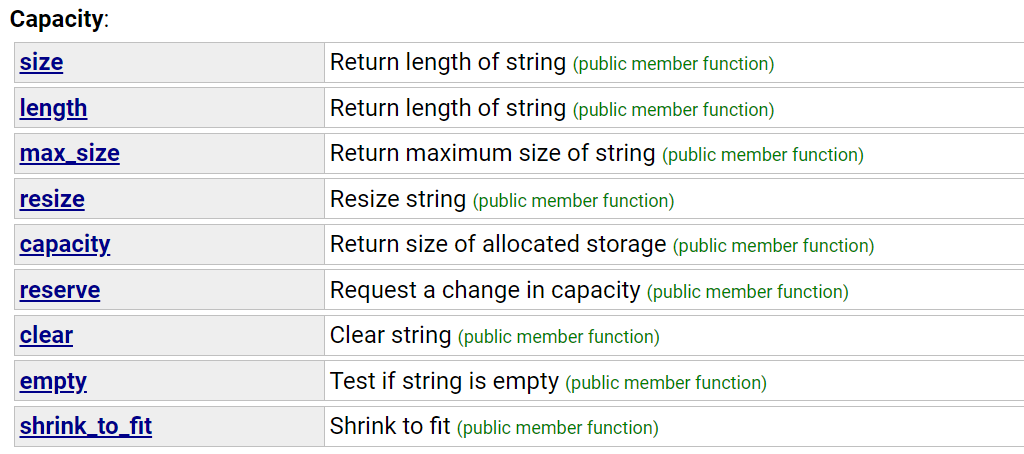

1、使用size函数或length函数获取当前有效字符的个数

#include <iostream>
#include <string>
using namespace std;
int main()
{
string s("CSDN");
cout << s.size() << endl; //4
cout << s.length() << endl; //4
return 0;
}
2、使用capacity函数获取当前对象所分配的存储空间的大小

#include <iostream>
#include <string>
using namespace std;
int main()
{
string s("CSDN");
cout << s.capacity() << endl; //15
return 0;
}
3、使用max_size函数获取string对象最多可包含的字符数
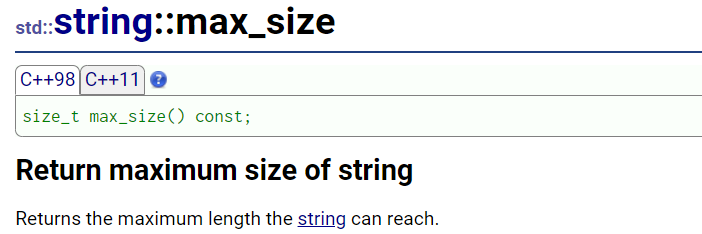
#include <iostream>
#include <string>
using namespace std;
int main()
{
string s("CSDN");
cout << s.max_size() << endl; //4294967294
return 0;
}
4、使用clear清除对象的内容,删除后对象变为空字符串

#include <iostream>
#include <string>
using namespace std;
int main()
{
string s("CSDN");
//clear()删除对象的内容,该对象将变为空字符串
s.clear();
cout << s << endl; //空字符串
return 0;
}
5、使用empty判断对象是否为空
为空返回true,不为空返回false

#include <iostream>
#include <string>
using namespace std;
int main()
{
string s("CSDN");
cout << s.empty() << endl; //0
//clear()删除对象的内容,该对象将变为空字符串
s.clear();
cout << s.empty() << endl; //1
return 0;
}
6、resize功能

规则:
| resize(n) | |
|---|---|
| n<size | 如果n小于当前字符串长度,则当前值将缩短到第n个字符,删除第n个字符以外的字符。 |
| size<n<capacity | 如果n大于size,且小于capacity,不产生扩容,将大于size的空间,若有给出指定字符c,则使用c填充,若c未给出,则默认为’\0’。 |
| n>capacity | 对字符串扩容,若给出的n大于对象当前的capacity,则capacity也会根据自己的增长规则进行扩大。 |
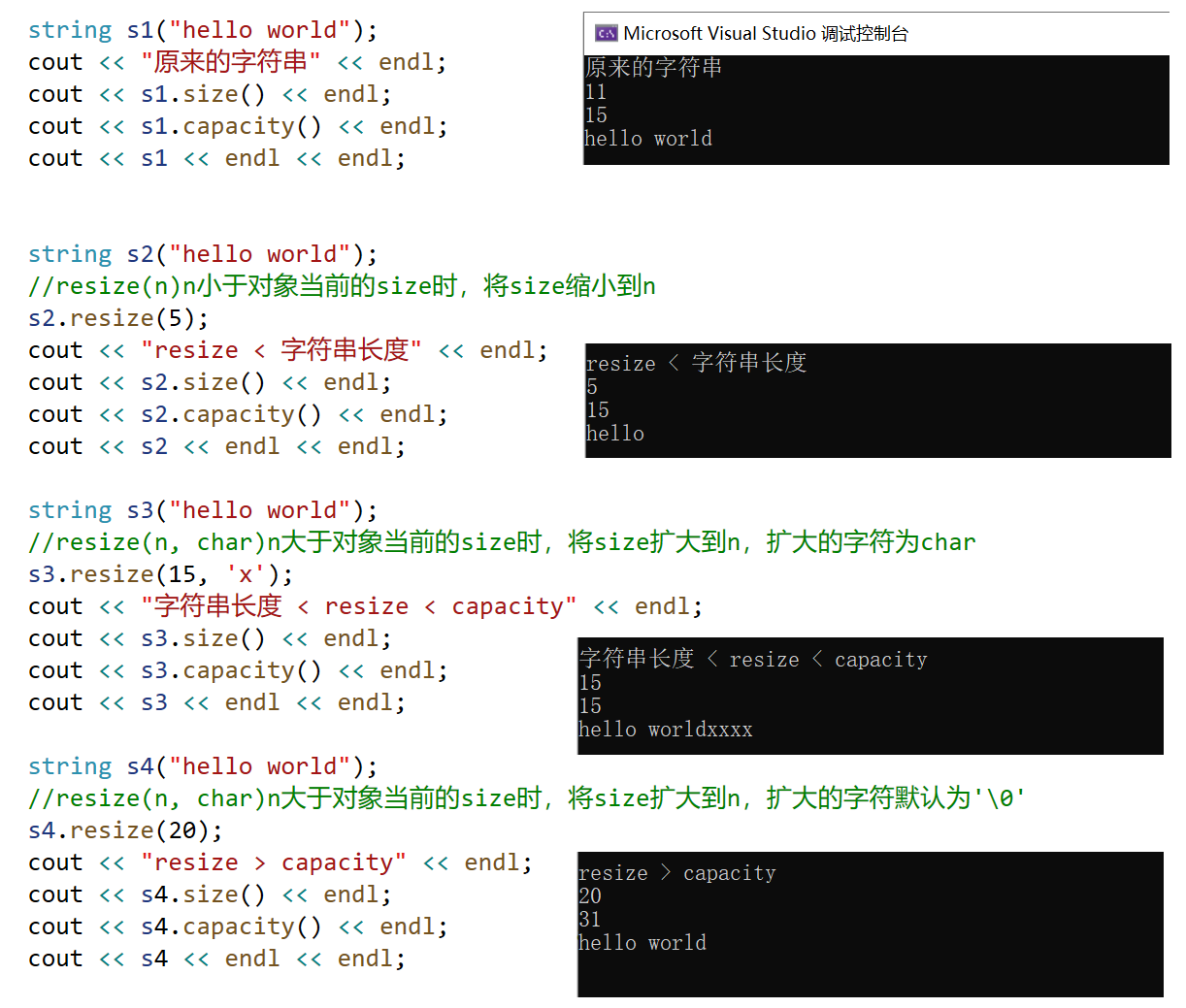
7、使用reserve改变当前对象的容量大小

reserve规则:
1、当n大于对象当前的capacity时,将capacity扩大到n或大于n。
2、当n小于对象当前的capacity时,什么也不做。
#include <iostream>
#include <string>
using namespace std;
int main()
{
string s("CSDN");
cout << s << endl; //CSDN
cout << s.size() << endl; //4
cout << s.capacity() << endl; //15
//reverse(n)当n大于对象当前的capacity时,将当前对象的capacity扩大为n或大于n
s.reserve(20);
cout << s << endl; //CDSN
cout << s.size() << endl; //4
cout << s.capacity() << endl; //31
//reverse(n)当n小于对象当前的capacity时,什么也不做
s.reserve(2);
cout << s << endl; //CDSN
cout << s.size() << endl; //4
cout << s.capacity() << endl; //31
return 0;
}
注意: 此函数对字符串的size没有影响,并且无法更改其内容。
8、shrink_to_fit的功能

四、 string类对象的修改操作
1. push_back:
尾插一个字符
void test_string()
{
string s1("hello world");
s1.push_back(' ');
s1.push_back('!');
cout << s1 << endl;//hello world !
}
2. append:
在字符串后追加一个字符串
常用传参方式:
string& append (const string& str);
string& append (const char* s);
string& append (size_t n, char c);
#include <iostream>
#include <string>
using namespace std;
int main()
{
string s1("I");
string s2(" like");
//append(string)完成两个string对象的拼接
s1.append(s2); //I like
//append(str)完成string对象和字符串str的拼接
s1.append(" C++"); //I like C++
//append(n, char)将n个字符char拼接到string对象后面
s1.append(3, '!'); //I like C++!!!
cout << s1 << endl; //I like C++!!!
return 0;
}
3. operator+=(重点):
string类中对+=运算符进行了重载,重载后的+=运算符支持string类的复合赋值、字符串的复合赋值以及字符复合的赋值

#include <iostream>
#include <string>
using namespace std;
int main()
{
string s1;
string s2("hello");
//支持string类的复合赋值
s1 += s2;
cout << s1 << endl; //hello
//支持字符串的复合赋值
s1 += " CSDN";
cout << s1 << endl; //hello CSDN
//支持字符的复合赋值
s1 += '!';
cout << s1 << endl; //hello CSDN!
return 0;
}
4. insert:
在pos位置插入
常用传参方式:
string& insert (size_t pos, const string& str);
string& insert (size_t pos, const char* s);
iterator insert (iterator p, char c);
#include <iostream>
#include <string>
using namespace std;
int main()
{
string s("C"); //C
//insert(pos, str)在pos位置插入字符串str
s.insert(1, "S"); //CS
//insert(pos, string)在pos位置插入string对象
string t("D");
s.insert(2, t); //CSD
//insert(pos, char)在pos位置插入字符char
s.insert(s.end(), 'N'); //CSDN
cout << s << endl; //CSDN
return 0;
}
5. erase:
在pos位置删除
常用传参方式:
string& erase (size_t pos = 0, size_t len = npos);//从pos位置删除len个字符,如果没有传len,则默认删除pos位置以及之后的所有字符
iterator erase (iterator p);
iterator erase (iterator first, iterator last);
#include <iostream>
#include <string>
using namespace std;
int main()
{
string s("I like C++!!!");
//erase(pos, n)删除pos位置开始的n个字符
s.erase(8, 5); //I like C
cout << s << endl; //I like C
//erase(pos)删除pos位置的字符
s.erase(s.end() - 1); //I like
cout << s << endl; //I like
//erase(pos1, pos2)删除[pos1pos2)上所有字符
s.erase(s.begin() + 1, s.end()); //I
cout << s << endl; //I
return 0;
}
6. assign:
assign可以理解成将原字符对象清空,重新进行赋值操作。
常用传参方式:
string& assign (const string& str);
string& assign (const char* s);
string& assign (const char* s, size_t n);
string& assign (size_t n, char c);
void test_string()
{
string s1("hello world hello world");
string s2("CSDN");
//将s1清空,替换指定string对象
s1.assign(s2);
cout << s1 << endl;//CSDN
//将s1清空,替换指定字符串
s1.assign("hello C++");
cout << s1 << endl;//hello C++
//将s1清空,替换指定字符串的一部分
s1.assign("hello C++", 5);
cout << s1 << endl;//hello
//将s1清空,替换n个指定的字符
s1.assign(5, '!');
cout << s1 << endl;//!!!!!
}
7. replace:
repalce是对字符对象的部分取代。
常用传参方式:
string& replace (size_t pos, size_t len, const string& str);
string& replace (size_t pos, size_t len, const char* s);
void test_string()
{
string s1("hello world hello world");
string s2("CSDN");
//从第六个下标位置开始,将五个字符替换成s2对象
s1.replace(6, 5, s2);
cout << s1 << endl;//hello CSDN hello world
//从第六个下标位置开始,将五个字符替换成指定字符串
s1.replace(6, 5, "C++");
cout << s1 << endl;//hello C++hello world
}
8. find:
使用find函数正向搜索第一个匹配项
常用传参方式:
size_t find (const string& str, size_t pos = 0) const;
size_t find (const char* s, size_t pos = 0) const;
size_t find (char c, size_t pos = 0) const;
#include <iostream>
#include <string>
using namespace std;
int main()
{
string s1("http://www.cplusplus.com/reference/string/string/find/");
//find(string)正向搜索与string对象所匹配的第一个位置
string s2("www");
size_t pos1 = s1.find(s2);
cout << pos1 << endl; //7
//find(str)正向搜索与字符串str所匹配的第一个位置
char str[] = "cplusplus.com";
size_t pos2 = s1.find(str);
cout << pos2 << endl; //11
//find(char)正向搜索与字符char所匹配的第一个位置
size_t pos3 = s1.find(':');
cout << pos3 << endl; //4
return 0;
}
9. rfind:
使用rfind函数反向搜索第一个匹配项
常用传参方式:
size_t rfind (const string& str, size_t pos = npos) const;
size_t rfind (const char* s, size_t pos = npos) const;
size_t rfind (char c, size_t pos = npos) const;
#include <iostream>
#include <string>
using namespace std;
int main()
{
string s1("http://www.cplusplus.com/reference/string/string/find/");
//rfind(string)反向搜索与string对象所匹配的第一个位置
string s2("string");
size_t pos1 = s1.rfind(s2);
cout << pos1 << endl; //42
//rfind(str)反向搜索与字符串str所匹配的第一个位置
char str[] = "reference";
size_t pos2 = s1.rfind(str);
cout << pos2 << endl; //25
//rfind(char)反向搜索与字符char所匹配的第一个位置
size_t pos3 = s1.rfind('/');
cout << pos3 << endl; //53
return 0;
}
10. substr
使用substr函数提取string中的子字符串
string substr (size_t pos = 0, size_t len = npos) const;//提取pos位置开始的len个字符序列作为返回值
提取文件的后缀
void test_string()
{
// "Test.cpp"
// "Test.cpp.tar"
string file;
cin >> file;
// 要求取后缀
//应该使用rfind,因为有些文件名可能有两个点
size_t pos = file.rfind('.');
if (pos != string::npos)
{
//string suffix = file.substr(pos, file.size() - pos);
string suffix = file.substr(pos);//提取pos位置开始的len个字符序列作为返回值
cout << suffix << endl;
}
}
11.c_str
获取字符数组首地址,用C字符串的形式遍历
const char* c_str() const;
void TestString()
{
//获取字符数组首地址,用C字符串的形式遍历
string s1("hello world");
const char* str = s1.c_str();
while (*str)
{
cout << *str << " ";
str++;
}
cout << endl;
s1 += '\0';
s1 += " hello";
cout << s1 << endl; //调用的string重载operator<< 将对象数组中所有字符都输出
cout << s1.c_str() << endl; //直接输出const char* 遇到\0结束
}
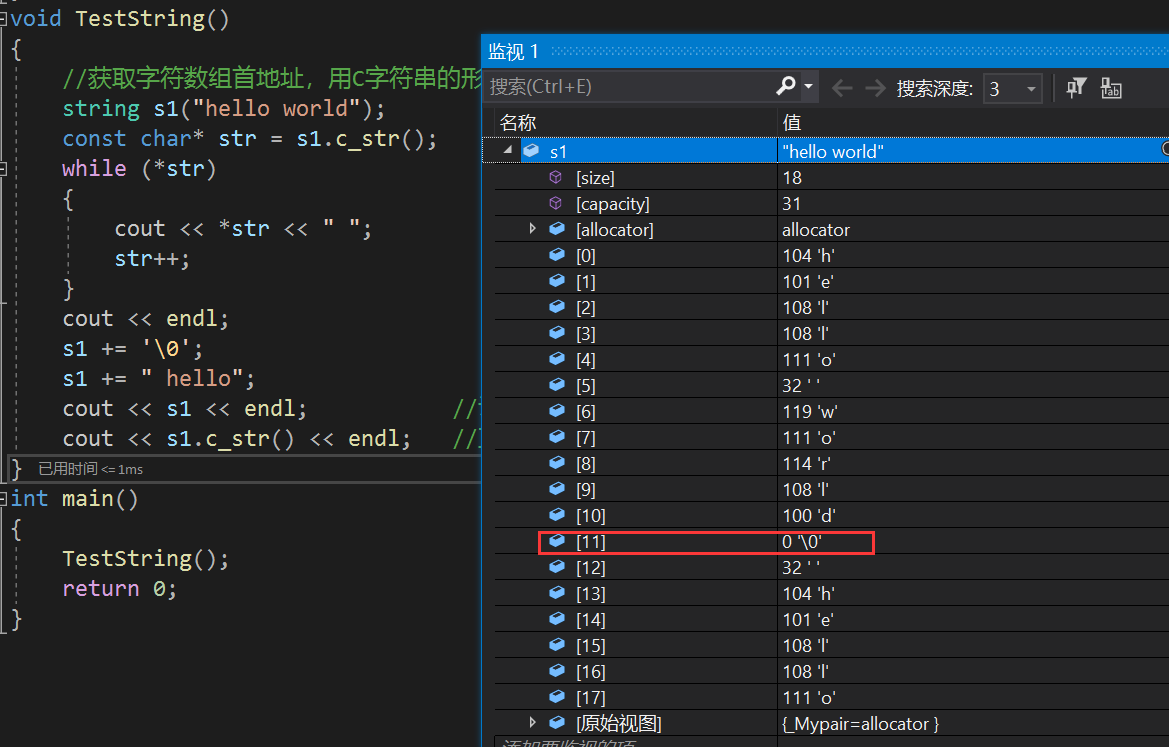

五、 string类非成员函数
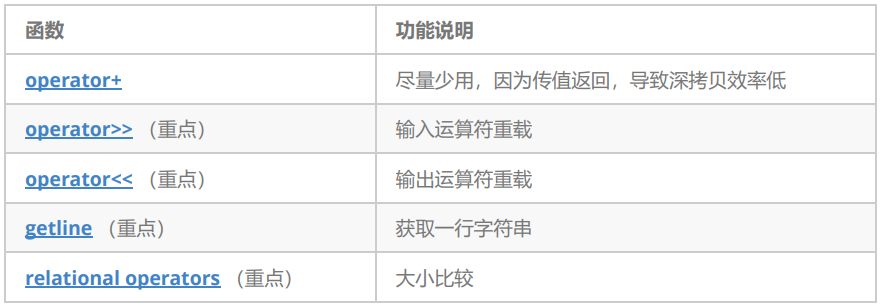
1.operator+
string类中对+运算符进行了重载,重载后的+运算符支持以下几种类型的操作:
string类 + string类
string类 + 字符串
字符串 + string类
string类 + 字符
字符 + string类
它们相加后均返回一个string类对象。
#include <iostream>
#include <string>
using namespace std;
int main()
{
string s;
string s1("hello");
string s2("world");
char str[] = "wyt";
char ch = '!';
//string类 + string类
s = s1 + s2;
cout << s << endl; //helloworld
//string类 + 字符串
s = s1 + str;
cout << s << endl; //hellowyt
//字符串 + string类
s = str + s1;
cout << s << endl; //wythello
//string类 + 字符
s = s1 + ch;
cout << s << endl; //hello!
//字符 + string类
s = ch + s1;
cout << s << endl; //!hello
return 0;
}
2. operator>> 和 operator<<
string类中也对>>和<<运算符进行了重载,这就是为什么我们可以直接使用>>和<<对string类进行输入和输出的原因。
istream& operator>> (istream& is, string& str);
ostream& operator<< (ostream& os, const string& str);
#include <iostream>
#include <string>
using namespace std;
int main()
{
string s;
cin >> s; //输入
cout << s << endl; //输出
return 0;
}
3. relational operators
string类中还对一系列关系运算符进行了重载,它们分别是==、!=、<、<=、>、>=。重载后的关系运算符支持string类和string类之间的关系比较、string类和字符串之间的关系比较、字符串和string类之间的关系比较。
#include <iostream>
#include <string>
using namespace std;
int main()
{
string s1("abcd");
string s2("abde");
cout << (s1 > s2) << endl; //0
cout << (s1 < s2) << endl; //1
cout << (s1 == s2) << endl; //0
return 0;
}
注意: 这些重载的关系比较运算符所比较的都是对应字符的ASCII码值。
4. getline
我们知道,使用>>进行输入操作时,当>>读取到空格便会停止读取,基于此,我们将不能用>>将一串含有空格的字符串读入到string对象中。
#include <iostream>
#include <string>
using namespace std;
int main()
{
string s;
cin >> s; //输入:hello CSDN
cout << s << endl; //输出:hello
return 0;
}
这时,我们就需要用getline函数完成一串含有空格的字符串的读取操作了。
用法一:
istream& getline (istream& is, string& str);
getline函数将从is中提取到的字符存储到str中,直到读取到换行符’\n’为止
#include <iostream>
#include <string>
using namespace std;
int main()
{
string s;
getline(cin, s); //输入:hello CSDN
cout << s << endl; //输出:hello CSDN
return 0;
}
用法二:
istream& getline (istream& is, string& str, char delim);
getline函数将从is中提取到的字符存储到str中,直到读取到分隔符delim或换行符’\n’为止。
#include <iostream>
#include <string>
using namespace std;
int main()
{
string s;
getline(cin, s, 'D'); //输入:hello CSDN
cout << s << endl; //输出:hello CS
return 0;
}